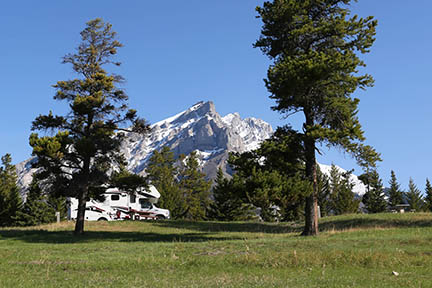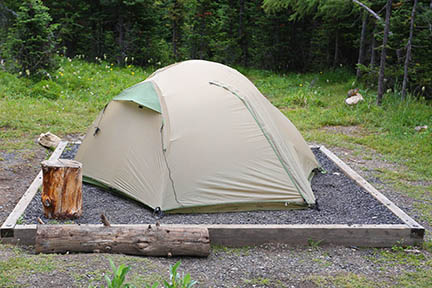Camping in the Canadian Rockies

Tunnel Mountain Campground is within walking distance of downtown Banff.
One of the most popular and least expensive ways to stay in the Canadian Rockies is by camping. Campgrounds are located in all national parks and throughout Kananaskis Country. Private campgrounds are located along all major highways leading into the Canadian Rockies.
National Park Campgrounds
Sites at most national park campgrounds can be reserved through Parks Canada Reservations (877/737-3783, www.reservation.pc.gc.ca) starting early in the year (check the website for opening dates), and it’s strongly recommended that you do reserve if you require electrical hookups or want to stay at one of the more popular campgrounds, such as Two Jack Lakeside. Some national park campgrounds are first-come, first-served, including most campgrounds along the Icefields Parkway. You will need to arrive early to ensure a spot, especially at Waterfowl Lakes (Banff National Park) and Mount Kerkeslin Campground (Jasper National Park). The official checkout time is 11am, so if you don’t have a reservation plan on arriving at your campground of choice earlier in the day than this to ensure getting a site.
For information about reserving a Canadian Rockies national park campsite in 2024 we recommend these pages:
Banff National Park Campground Reservations in 2024
Jasper National Park Campground Reservations in 2024
Yoho National Park Campground Reservations in 2024
Kootenay National Park Campground Reservations in 2024
Waterton Lakes National Park Campground Reservations in 2024
provincial Park Campgrounds
Every weekend throughout summer, thousands of Calgarians flee the city for the mountains. Kananaskis Country (and Peter Lougheed Provincial Park in particular) is the most popular destination. Even with 2,100 campsites in 30 campgrounds, sites fill fast. Reservations are taken for many Kananaskis Country campgrounds through Reserve Alberta Parks. Reservations can be made up to three months in advance of your stay. Other campgrounds are first-come, first-served, but you’ll need to arrive early to get a site, especially on Fridays.
Backcountry Camping

Backcountry campsite at Mount Assiniboine Provincial Park.
Due to the growth in Canadian Rockies backcountry camping, with very few exceptions, you will be required to stay in designated campgrounds. Mostly, these campgrounds have quotas on the number of people who can overnight there and most sites are by reservation only.
Most backcountry campgrounds in the national parks require reservations, and you’ll need to make these as early as possible. The Parks Canada Reservation Service (877/737-3783, www.reservation.pc.gc.ca) opens early in the year for the upcoming summer and many campgrounds fill for the season within hours of the reservation system opening (check the website for opening dates).
Banff and Yoho are the only national parks were random camping is permitted, but only in specific areas where visitation is low. In selecting a campsite in a random camping zone, you must be five kilometres (3.1 miles) from a trailhead, at least 50 metres (160 feet) off the trail, and 70 metres (230 feet) from the nearest stream or lake.
Lake O’Hara Campground in Yoho National Park is the most popular place for backcountry camping in the Canadian Rockies. For more information, check out the Lake O’Hara Travel Guide.
Most provincial parks have backcountry camping fees based on a per person/per night basis. Camping permits are required for all backcountry campgrounds in Alberta’s Peter Lougheed Provincial Park, for sites in Mount Assiniboine Provincial Park, and for sites on the Berg Lake trail in B.C.’s Mount Robson Provincial Park. These permits are obtained in person at park visitor centres or in advance through special reservation phone lines.